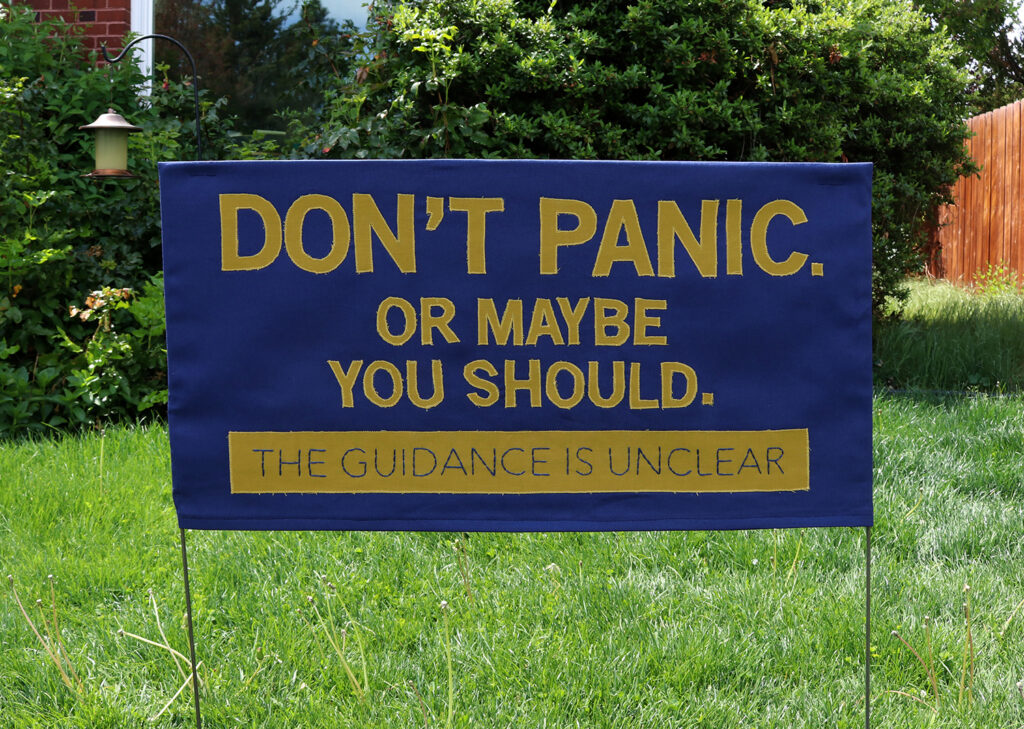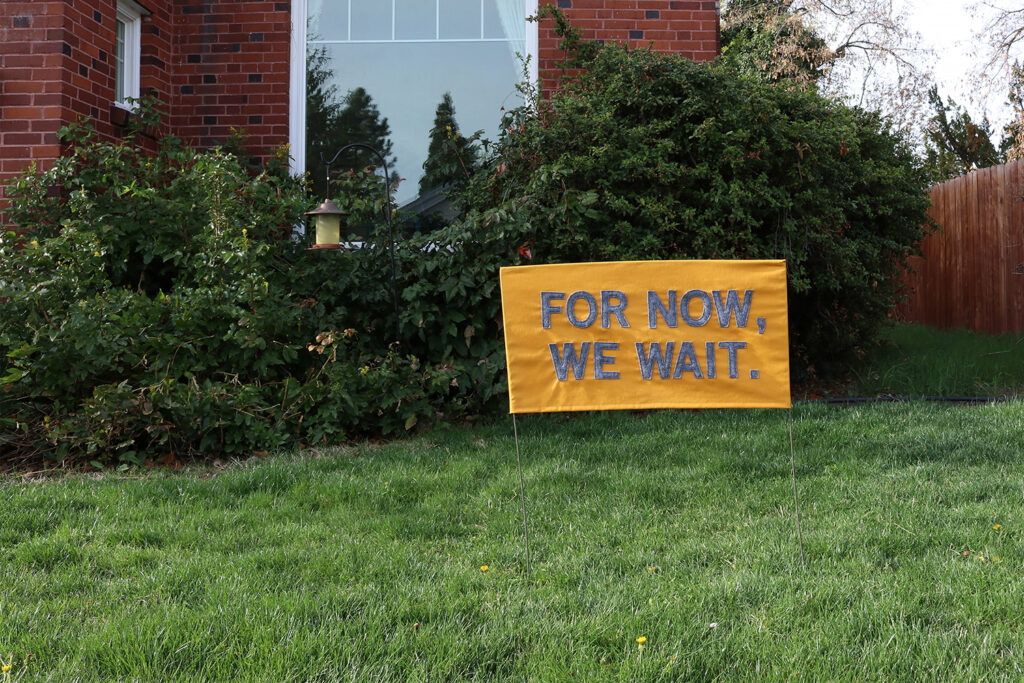In May, we wanted to bring back our 5Q’s series and touch base with Reno-based artist Jen Graham about their recent work. Jen is known for expertly crafted fiber works that engage in the political and her work has been exhibited nationally including numerous exhibitions at The Holland Project with an upcoming exhibition at our offsite space in Ferino Distillery. You can follow their work on Instagram at @jengrahamart or at jengrahamart.com.
1. Please tell us about what you’ve been up to during the stay-home order in Nevada which began mid-March, your lawn sign project, and how this project relates to your previous work.
When the reality of the pandemic hit us in the US, and I watched museums and art spaces close across the country, I wanted to find a way to (safely) bring some art out into the physical world. I remembered that I had this metal lawn sign frame left over from the Warren for President sign I had out during the primary, and I decided to make new signs for the frame that contain brief messages for passersby. I love sending postcards, and I see these as large-scale postcards to my neighborhood. They’re just little thoughts I’m sending along for others to read and consider or discard.
My previous work mostly consists of embroidery and fiber art that discusses current political and social issues. The weight of the work varies, but it’s all my commentary about the world around me. The lawn signs are as well.

2. Curious about reactions to this project outside of social media. Anything notable, heart-warming, or surprising from passersby or neighbors?
I have seen a few people stop and react to a sign as they’re walking down my street, and I’ve had some neighbors tell me they’ve enjoyed stumbling across the signs. But I don’t spend a lot of time watching to see if anyone notices the signs. Even in a gallery setting, I am uncomfortable watching people look at my work. A viewer can’t have an honest reaction if they’re being watched.
3. Any strange vulnerable feelings by putting art on the lawn? You know, I’m too freaked to put a political bumper sticker on my car or water bottle even though I love to see it on others. Obsessed over a homemade one for Bernie not that long ago, but would never do it. Do you experience any of this anxiety? Or is it empowering to put it out there? Or maybe just different because this work is not an endorsement, but comments and markers of time?
I absolutely have anxiety about putting these signs on my lawn. I have displayed political signs for candidates, and it did take me a while to get the courage to do that, but there’s more of a vulnerability to putting my artwork out there. In a gallery or museum setting, it’s easy to separate yourself from the work. Outside of opening receptions, the viewer is seeing only the work and nothing of the artist. But with these lawn signs, I am directly connecting my work with my home, with myself. I am a reclusive, private person, so this makes me very uncomfortable. And it does dictate, to some extent, what I do and do not say with the signs. I don’t want to be aggressive or confrontational, because I don’t think this is the setting for that. I have to think about what I want the role of these signs to be in the lives of the people who happen upon them. When someone is choosing to look at a work of art, I can push things further. But when someone is being confronted by art out of nowhere, in their neighborhood, I don’t want to scream at them. I just want to make them pause and think for a moment. I’m not saying there is no place in the public sphere for more confrontational work; I absolutely think there is. I just don’t think my lawn is the place for this approach.

4. Thinking about work that engages in the political, do you ever think there is a difference between the work you want to make and work that is important or you are compelled to make? And do you ever imagine what you might be creating if the world was more peaceful and just?
The work that feels important to me, that I am compelled to make, is the work that I want to make. I am an emotional, anxious person that worries about the whole world, and I need to feel like I am contributing to positive change in the best way that I can. I don’t have the kind of skills or personality that is required to run for office or lead a movement. This is the only way I know how to contribute to the conversation, to help make change. I don’t know if my work will ever make any real difference, but I have to try. At the very least, it gives me an outlet to process my frustrations and disappointment with the world. I have no idea what kind of work I would be making in a better world, but I would love to find out.
5. How important personally is longevity in your work? While some phrases or imagery throughout your portfolio may feel timeless, is it OK for some works to be short-lived when responding to topical issues?
Longevity of my work is not important to me. I’m making work that comments on current events and politics, things that are continually changing. As the context changes, the meaning of the work changes, or the work simply becomes irrelevant. For the most part, I would love to see all of my work become irrelevant, just relics of our history. That would mean that the problems I am addressing have been resolved. What I don’t want, and what has happened for much of my work, is for it to become more relevant.

Jen Graham is a fiber artist from Reno, Nevada. Embracing the history of the sewing arts as a form of storytelling, recording family history, and protest, she uses traditional embroidery and sewing techniques to both reinvestigate American history and discuss current political and social issues. She has exhibited her work in both solo and group exhibitions throughout the United States, including at the Nevada Museum of Art, the San Jose Museum of Quilts and Textiles, and the Muskegon Museum of Art.
